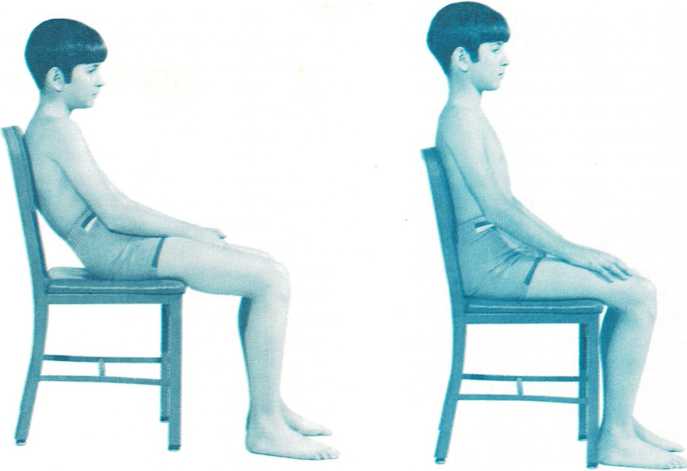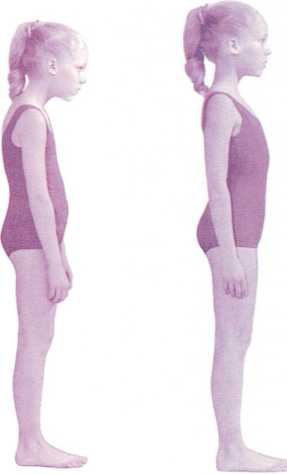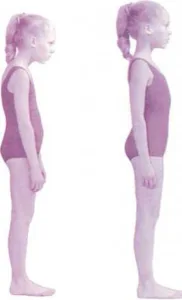Poliomyelitis – Posture
Poliomyelitis (infantile paralysis or polio) is a serious contagious
disease that is characterized by inflammation of the brain and spinal
cord. It is caused by a virus.
Posture is the way children hold the body as they stand, sit, and
move. Good posture is important for good appearance and good health.

Poor sitting posture (above left) can cause swayback, backache,
round shoulders, spinal curvature, muscle strain, and can hinder normal
functioning of body organs. In a good sitting position (above right),
a child should sit well back on the chair, with both feet squarely on
the floor. The head should be over the shoulders, and the back should be
straight.

Poor standing posture is shown above left. In a good standing position
(above right), the head should be balanced over the shoulders, the
chest held high, the shoulders back, and the abdomen drawn in.
When a child with good posture stands, the child holds the head up,
balanced over the shoulders. The chest is held high, the shoulders are
back, and the abdomen is drawn in. Weight rests equally on both feet.
When a child with good posture walks, feet point nearly straight ahead
and the child leads with thighs and knees.
If a child has poor standing posture, the head falls forward, the
shoulders are rounded, the back curves, the chest slopes, and the
abdomen sags.
When a child with good posture sits, hips are against the back of the
chair and feet are flat on the floor. Body weight rests on both thighs
to evenly distribute the weight. When leaning forward to write, the
child bends from the hips instead of curving the back.
When a child with good posture lifts heavy objects, leg muscles, not
back muscles, are used. The child stands close to the object, bends the
knees, keeps the back straight, and lifts the object.
Poor posture can cause swayback, spinal curvature, round shoulders, and
backaches. Body weight is abnormally distributed and
can strain leg muscles. Lifting heavy objects with the body in poor
posture can strain back muscles.
Nagging a child to “Stand up straight!” and “Square your shoulders!”
does not help the child acquire good posture. A child with the double
problem of bad posture and nagging parents is likely to sag and slump
all the more. A child more readily listens to a doctor and takes part in
good-posture campaigns at school. Bicycling, walking, basketball, and
other sports may also help improve a child’s posture, [m.g.]
See also Scoliosis
Prescriptions are usually w\’ritten directions provided by a doctor
to prevent or treat an illness. Most prescriptions are for medicines,
but prescriptions may also be given for diet, physical therapy,
eyeglasses, and exercises. At the top of the prescription form you may
notice an B, which stands for the Latin wmrd recipe, meaning “take.”
Have all prescriptions filled by a qualified pharmacist. Follow exactly
the doctor’s instructions for giving the medicine. Remember that almost
all medicines are harmful if taken in larger amounts than prescribed.
And a last word of caution: never give medicine prescribed for one
member of the family to another whose symptoms seem to be similar. The
cause and treatment of the second illness may be entirely different from
the illness for which the medicine had been prescribed,
[m.g]
See also Drugs; Medicine cabinets

